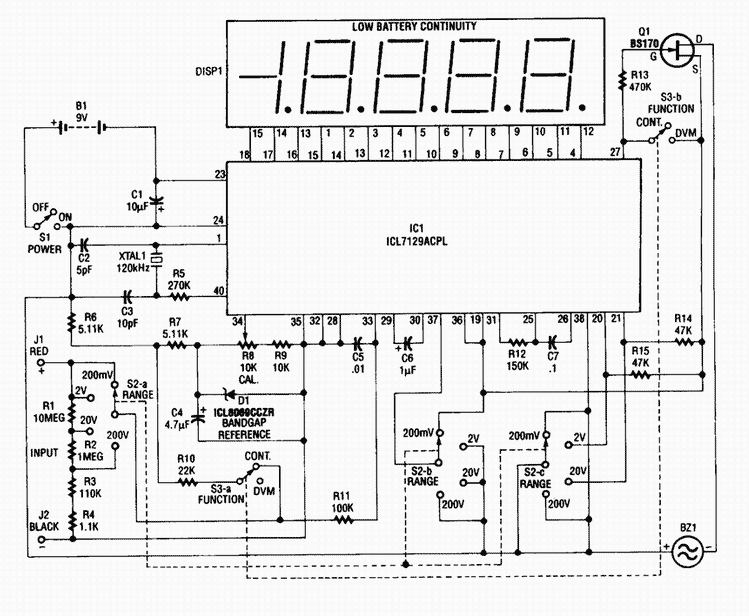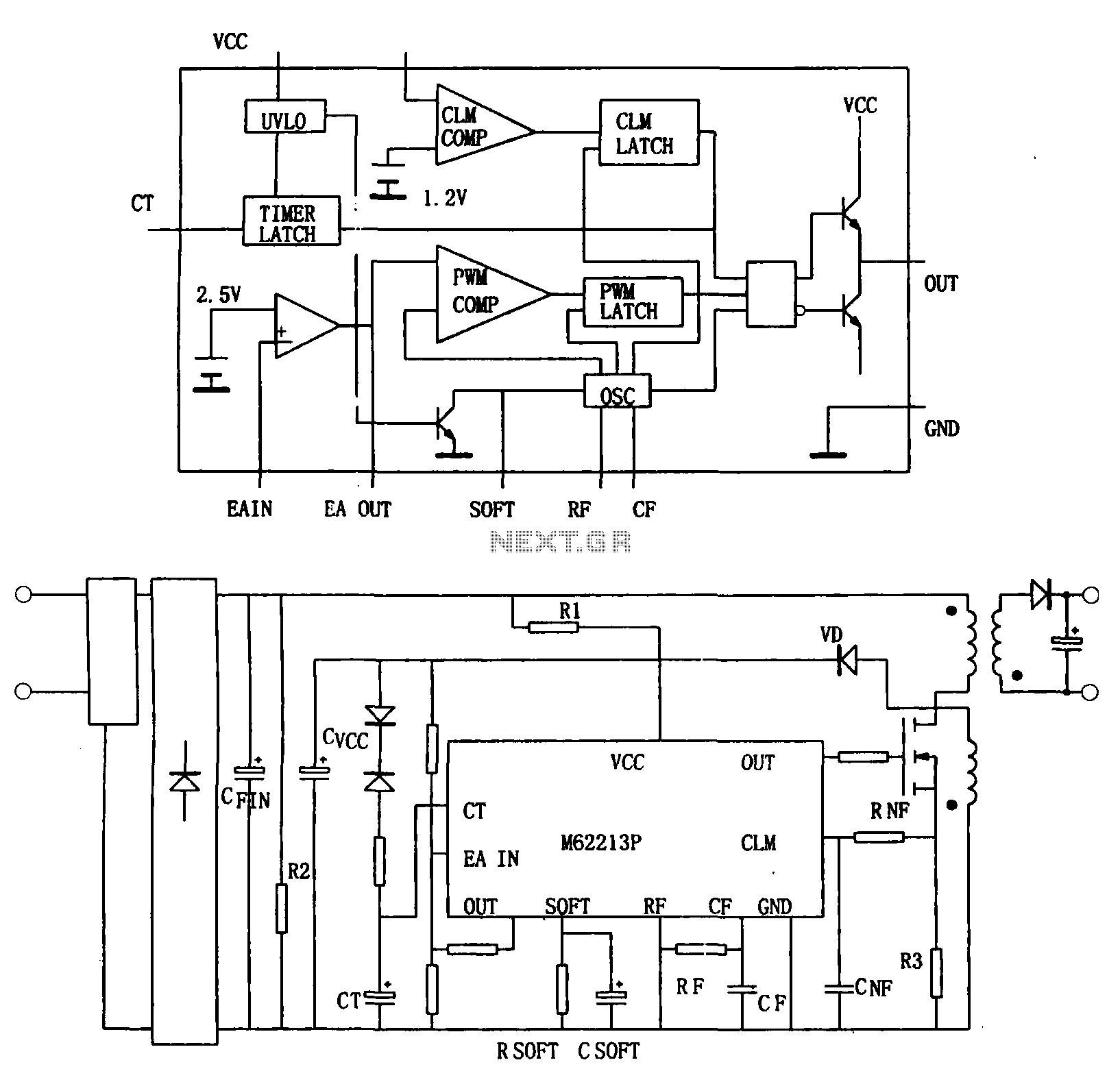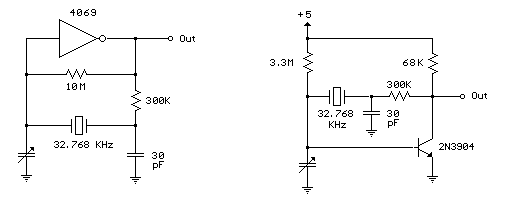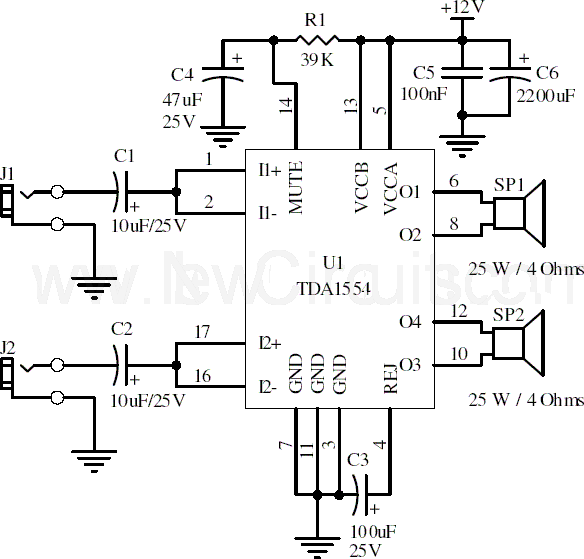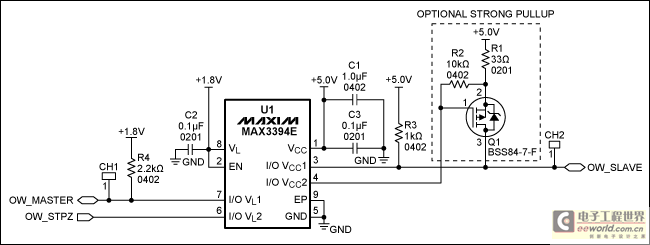
High Precision Voltage-to-Frequency Converter (VFC) Using CA3130 Op-Amps
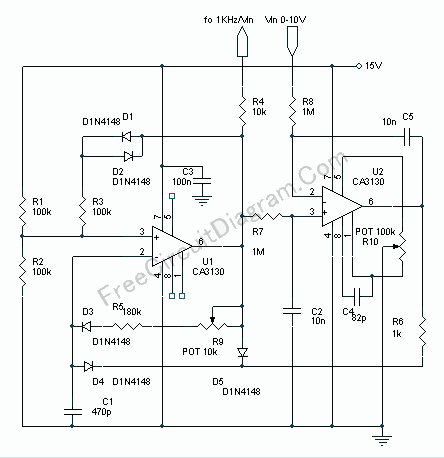
Voltage to frequency conversion is highly beneficial in various applications, such as transmitting temperature measurements using standard voice radio transceivers. This circuit utilizes two CA3130 operational amplifiers, demonstrating satisfactory performance. The linearity of the voltage-frequency transfer is better than 0.5%, and the temperature coefficient is lower than 0.01%. Assuming the output voltage of U1 is 15V, capacitor C1 charges with a time constant determined by the resistors R9 and R5, flowing through R9, R5, D3, and C1. This charging continues until the voltage at pin 2 of U1 exceeds the non-inverting input voltage at pin 3. Following this, the output voltage of U1 drops to zero (ground), and the non-inverting input at pin 3 decreases to approximately 5V, set by resistor R3 for hysteresis. Subsequently, C1 discharges its current through D4 and R6, at a rate dictated by the output voltage level of U2. If the voltage across C1 falls below 5V, the output of U1 will swing back to 15V, restarting the cycle. The positive input of U1 reflects the average of its pulse output. U1 produces a positive pulse with a constant width, while the spacing between pulses varies based on the discharging rate of C1, which is influenced by U2's output. If the voltage at U2's positive input is lower than the control voltage at its negative input, the output of U2 decreases towards the negative supply (ground), increasing the discharging rate of C1 and shortening the pulse spacing from U1. This, in turn, raises the voltage level at C3 until it equals the control voltage at U2's negative input. Conversely, if the voltage at the positive input exceeds the negative input, U2's output rises towards the positive supply (15V), prompting an opposite action to equalize the positive and negative inputs. Diodes D3 and D4 are used to separate the control of C1's charging and discharging phases; since these diodes exhibit varying characteristics at different temperatures, diodes D1, D2, and resistor R3 are included to introduce a similar reference voltage variation at the positive input, mirroring the negative voltage variation caused by D3 and D4. A potentiometer R10 is used to correct the offset error of U2, while R9 is employed to fine-tune the voltage-to-frequency conversion rate to precisely achieve 1 kHz/Volt.
The circuit operates by converting an input voltage into a frequency signal, which is particularly useful for applications requiring the transmission of analog signals over radio frequency channels. The use of CA3130 op-amps ensures low offset voltage and high input impedance, which is essential for accurate voltage sensing, especially in temperature measurement scenarios.
The charging and discharging of capacitor C1 create a timing mechanism that directly relates to the input voltage level. The hysteresis introduced by resistor R3 prevents rapid oscillations of the output and ensures stable operation. The feedback loop involving U2 allows for dynamic control of the discharging rate of C1, enabling the pulse frequency to vary according to the input voltage.
The diodes D3 and D4 play a critical role in isolating the charging and discharging paths, ensuring that the circuit maintains accuracy despite temperature variations. The additional components, D1, D2, and R3, are necessary for compensating the effects of temperature on the diode characteristics, thereby stabilizing the circuit’s performance over varying environmental conditions.
Overall, this voltage-to-frequency converter circuit is a robust solution for applications in telemetry and remote sensing, where reliable transmission of analog signals is required. By fine-tuning the circuit parameters, such as the values of R9 and R10, the design can be adapted to meet specific operational requirements, ensuring optimal performance in real-world applications.Voltage to frequency is very useful in many situation, such as transmitting temperature measurement using standard voice radio transceiver. This circuit (see the circuit`s schematic diagram) uses only two CA3130 op-amps, but the performance is good enough.
The linearity of the voltage-frequency transfer is better than 0. 5% and the temperature coef ficient is lower than 0. 01% ! Assume that the output voltage of U1 is 15V, C1 will be charged with time constant (R9 R5)C1, flowing through R9, R5, D3, and C1. This charging will continue until the voltage of pin 2 (U1) get higher than the non-inverting input voltage at pin 3.
After this, the output voltage of U1 will drop to zero (ground) and the non-inverting input pin 3 will drop to about 5V, set by the R3 for hysteresis. Now C1 will discharge its current through D4 and R6, at a rate determined by the voltage level at U2 output.
If the C1 voltage has decreased below 5 volt then the U1 output will swing to 15V and the cycle will be restarted. At U1 positive input, the voltage level is the average of the pulse output of U1. The output of U1 is a positive pulse with constant width, and the space is variable depends on the discharging rate of C1 which is depend on U2 output.
If the voltage level of this positive input of U2 is smaller than the control voltage at the negative input then the output of U2 will decreased toward negative supply (ground), therefore the discharging rate of C1 will be increased and the pulse output of the U1 will have shorter space, thus increase the voltage level at C3 until the it`s equal to the control voltage level at negative input of U2. If the voltage level at positive input is higher than the negative input, then the output of U2 will increase toward positive supply (15V) giving a reversed action to keep the level of negative and the positive input equal.
Because D3 and D4 are needed to separate the charging and discharging control of C1, and the diodes have different characteristics at different temperature, D1, D2, and R3 are provided to introduce similar reference voltage variation of positive input as seen in the negative voltage variation caused by D3 and D4 at different temperatures. Use R10 pot to correct the offset error of U2 and R9 to fine tune the voltage-to-frequency conversion rate to exactly 1kHz/Volt.
[Schematic Source: RCA Application Note] 🔗 External reference
The circuit operates by converting an input voltage into a frequency signal, which is particularly useful for applications requiring the transmission of analog signals over radio frequency channels. The use of CA3130 op-amps ensures low offset voltage and high input impedance, which is essential for accurate voltage sensing, especially in temperature measurement scenarios.
The charging and discharging of capacitor C1 create a timing mechanism that directly relates to the input voltage level. The hysteresis introduced by resistor R3 prevents rapid oscillations of the output and ensures stable operation. The feedback loop involving U2 allows for dynamic control of the discharging rate of C1, enabling the pulse frequency to vary according to the input voltage.
The diodes D3 and D4 play a critical role in isolating the charging and discharging paths, ensuring that the circuit maintains accuracy despite temperature variations. The additional components, D1, D2, and R3, are necessary for compensating the effects of temperature on the diode characteristics, thereby stabilizing the circuit’s performance over varying environmental conditions.
Overall, this voltage-to-frequency converter circuit is a robust solution for applications in telemetry and remote sensing, where reliable transmission of analog signals is required. By fine-tuning the circuit parameters, such as the values of R9 and R10, the design can be adapted to meet specific operational requirements, ensuring optimal performance in real-world applications.Voltage to frequency is very useful in many situation, such as transmitting temperature measurement using standard voice radio transceiver. This circuit (see the circuit`s schematic diagram) uses only two CA3130 op-amps, but the performance is good enough.
The linearity of the voltage-frequency transfer is better than 0. 5% and the temperature coef ficient is lower than 0. 01% ! Assume that the output voltage of U1 is 15V, C1 will be charged with time constant (R9 R5)C1, flowing through R9, R5, D3, and C1. This charging will continue until the voltage of pin 2 (U1) get higher than the non-inverting input voltage at pin 3.
After this, the output voltage of U1 will drop to zero (ground) and the non-inverting input pin 3 will drop to about 5V, set by the R3 for hysteresis. Now C1 will discharge its current through D4 and R6, at a rate determined by the voltage level at U2 output.
If the C1 voltage has decreased below 5 volt then the U1 output will swing to 15V and the cycle will be restarted. At U1 positive input, the voltage level is the average of the pulse output of U1. The output of U1 is a positive pulse with constant width, and the space is variable depends on the discharging rate of C1 which is depend on U2 output.
If the voltage level of this positive input of U2 is smaller than the control voltage at the negative input then the output of U2 will decreased toward negative supply (ground), therefore the discharging rate of C1 will be increased and the pulse output of the U1 will have shorter space, thus increase the voltage level at C3 until the it`s equal to the control voltage level at negative input of U2. If the voltage level at positive input is higher than the negative input, then the output of U2 will increase toward positive supply (15V) giving a reversed action to keep the level of negative and the positive input equal.
Because D3 and D4 are needed to separate the charging and discharging control of C1, and the diodes have different characteristics at different temperature, D1, D2, and R3 are provided to introduce similar reference voltage variation of positive input as seen in the negative voltage variation caused by D3 and D4 at different temperatures. Use R10 pot to correct the offset error of U2 and R9 to fine tune the voltage-to-frequency conversion rate to exactly 1kHz/Volt.
[Schematic Source: RCA Application Note] 🔗 External reference
Warning: include(partials/cookie-banner.php): Failed to open stream: Permission denied in /var/www/html/nextgr/view-circuit.php on line 713
Warning: include(): Failed opening 'partials/cookie-banner.php' for inclusion (include_path='.:/usr/share/php') in /var/www/html/nextgr/view-circuit.php on line 713
